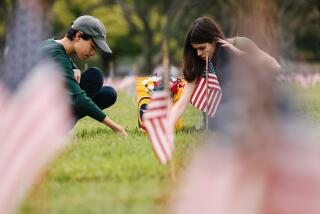Rites for Gen. Vang Pao a crossroads of Hmong tradition and modern U.S.
Reporting from Fresno — They promised a funeral fit for a king.
There were to be dignitaries; a long red carpet; thousands of pigs, cows, chickens and ducks to be sacrificed for feasting.
It had to be a funeral that crossed cultures and time, peace and war. For this was both goodbye to one man and to the founding era of a people.
So thousands of mourners — including the exiled prince of Laos, widows of Hmong soldiers who died in a “secret” war and families who battled an East Coast blizzard to make it in time — lined the streets Friday for a procession marking the start of an elaborate six-day funeral for Gen. Vang Pao, leader of the Hmong people and a key ally of the United States during the Vietnam War.
Women in traditional Hmong clothing stood shoulder to shoulder for three blocks, forming a wall of black that was accented with bright pink, green, blue and orange — their different sashes and exotic headpieces symbolizing different provinces in Laos.
Men wore suits with crisp, white shirts —- the color of peace. Inside the convention center were hundreds of wreaths of white carnations, burning white candles, and white bunting.
“I look at all this — the different colors and costumes and ages and all the people and I think ‘It is all Hmong.’ Gen. Vang Pao made us one people,” said Victor Xiong, 15, of Fresno.
Vang Pao was the first in 500 years to unite about 18 different Hmong clans. He led the Hmong, a remote, rural ethnic minority who lived in the mountains of Laos, into war, siding with the Americans against the communists in a secret front of the Vietnam War. When the United States lost the war, the Hmong were left hunted and on the run.
Many of those who survived and escaped came to the United States as refugees, and about 30,000 live in California’s Central Valley. Vang Pao was a father figure to the community as it grappled with moving from an ancient, agrarian lifestyle, without a written language, to modern American life.
Such great sweeps of history played out in personal conversations at Vang Pao’s funeral.
Retired Air Force Brigadier Gen. Art Cornelius, once one of the pilots who flew secret missions into Laos during the Vietnam era, talked with Peter C. Vang.
“He has five children. They all went to college,” Cornelius said. “He was gravely wounded in Laos. I was afraid he wasn’t going to make it. He is very important to me.”
Cornelius laughed when asked what made him so close to Vang, now a Portland, Ore., city worker.
“Fly 100 missions with a guy with gunshots everywhere. You get to like him,” Cornelius said.
Hundreds of members of the Special Guerrilla Unit, the CIA-backed Hmong army, wearing camouflage uniforms, were seated at the front section and followed the casket in the procession outside the Fresno Convention and Entertainment Center. The widows of Hmong soldiers stood together along the route.
“The general led us into war and into this American world. We worry that the American people will not love us without the general here with us,” said Neng Vue, 65, whose husband, Chong Nyia Vang, was a soldier killed during the war. “He was our leader and our father.”
While the funeral was in progress, it was announced that a request to bury Vang Pao in Arlington National Cemetery had been denied because Vang Pao and the soldiers who fought under him to help the U.S. did not directly serve in the American military.
For the Hmong, the days since Vang Pao died Dec. 6 in Clovis, Calif., at the age of 81 have been a mix of ancient traditions and the modern world.
A cameraman filming for an Internet broadcast of the funeral wore a red arm band to ward off evil spirits. Elderly Hmong women arranged a spokeswoman’s sash so it would be full in back, like a “proper Hmong woman,” while her sister told her she needed more lip gloss.
In much of Fresno County there’s nary a cow, chicken, duck or pig left unsold. Animal sacrifices, and big barbecues feeding friends and family during funerals, are part of the Hmong’s tradition. But there will be no animal sacrifice during the funeral because it’s at the convention center.
There will be songs and poetry, and Hmong flute and funeral drums, which are believed to communicate with the spirit world.
A key part of a Hmong funeral is qhuab ke, or “showing the way.” A guide takes the spirit of the deceased back through each place and time it has lived, giving thanks and honor to each, before sending it on its own into the future.
As the body of Vang Pao arrived, the conversations between friends, some of whom had not seen one another in 30 years, quieted. Old Hmong soldiers in uniform, young Hmong beauty queens in tiaras, families holding hands, all filled the street and followed the horse-drawn carriage carrying Vang Pao’s casket.
They had come to give thanks and honor before going forward alone.
Marcum is a special correspondent
More to Read
Sign up for Essential California
The most important California stories and recommendations in your inbox every morning.
You may occasionally receive promotional content from the Los Angeles Times.











